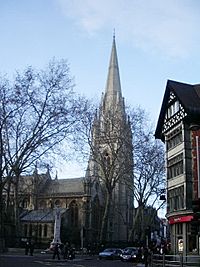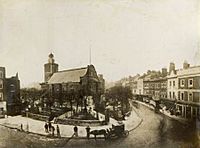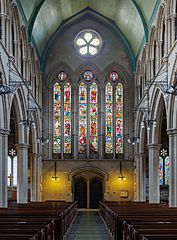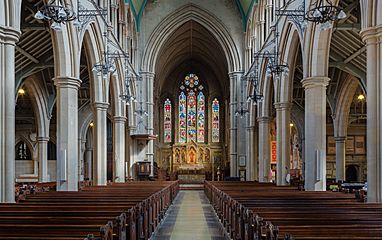St Mary Abbots facts for kids
Quick facts for kids St Mary Abbots |
|
|---|---|

St Mary Abbots Church in 2007
|
|
| OS grid reference | TQ 25605 79707 |
| Location | Kensington Church Street, Kensington, London W8 4LA |
| Country | England |
| Denomination | Church of England |
| Churchmanship | High Church |
| History | |
| Status | Parish church |
| Consecrated | 1262 |
| Architecture | |
| Functional status | Active |
| Heritage designation | Grade II* |
| Architect(s) | Sir George Gilbert Scott |
| Style | Neo-Gothic |
| Completed | 1872 |
| Specifications | |
| Capacity | 700 |
| Length | 179 feet (55m) |
| Width | 109 feet (34m) |
| Number of spires | One |
| Spire height | 278 feet (85m) |
| Administration | |
| Parish | Kensington |
| Deanery | Kensington |
| Archdeaconry | Middlesex |
| Episcopal area | Kensington |
| Diocese | London |
| Province | Canterbury |
St Mary Abbots is a famous church in Kensington, a part of London. It is located on Kensington High Street. The church is well-known for having the tallest church spire in all of London!
The building you see today was finished in 1872. It was designed by the architect Sir George Gilbert Scott. He used a style called Neo-Gothic, which was inspired by old English churches. Even though the current building is from the 1800s, there has been a church on this spot since the 1100s. Because of its history and beautiful design, the church is a special protected building, listed as Grade II*.
Contents
History of the Church
How It All Began
The story of St Mary Abbots starts over 900 years ago. After the Norman Conquest of England, a knight named Sir Aubrey de Vere was given the land of Kensington. Around the year 1100, his oldest son, Godfrey, became very sick.
Godfrey was cared for by an abbot (the head of a monastery) named Faritius. Faritius was from the Abbey of St Mary in Abingdon. Sadly, Godfrey died when he was only about 19 years old. To thank the abbey for taking care of their son, the de Vere family gave them a large piece of land in Kensington.
In 1262, the abbey built a church on this land. They named it St Mary, after their own abbey. The name "Abbots" was added to show its connection to the abbots of Abingdon. This is how the church got its full name: St Mary Abbots.
New Buildings Over the Centuries
The first church on the site was built in the Norman style. In 1370, it was rebuilt. Hundreds of years later, in 1689, King William III of England moved his royal court to Kensington Palace. This made the area very popular, and many people moved there. The old church was now too small for everyone.
So, at the end of the 1600s, the church was torn down and a new, larger one was built. But as London grew even more in the 1800s, this church also became too small.
Around 1860, the church's leader, John Sinclair, decided a grand new church was needed. He hired the famous architect Sir George Gilbert Scott. Scott suggested tearing down the old church to build a much bigger one. The new church's tall spire was inspired by another famous church, St Mary Redcliffe in Bristol. The church we see today still has many old monuments and decorations from the earlier churches.
Surviving World War II
During World War II, in March 1944, the church was hit by fire-bombs. The roof over the main part of the church, called the nave, fell in. Some of the beautiful stained-glass windows and the organ were also damaged.
Luckily, the main stone structure of the church was not badly harmed. The church was fixed up so that services could continue. If you visit today, you can still see burn marks on the wooden pews from the fire.
The Church Bells
The church tower has a set of ten bells. These bells are rung in a special way called change ringing. Five of the bells are very old, made in 1772. The other five were made in 1879, when the current church was built. This means some of the bells have been ringing for over 250 years!
St Mary Abbots School
Next to the church is a primary school that is connected to it. The school was started in 1707 to give an education to local children. The current school building was built in 1875.
On the outside of the school, you can see two stone statues of a boy and a girl. These statues are from around 1715 and were part of the original school. The school and the church still have a close relationship today.
Famous People Connected to the Church
Over the centuries, many well-known people have attended St Mary Abbots or have a connection to it.
- Sir Isaac Newton, the famous scientist, is remembered with a special window in the church.
- Beatrix Potter, the author of the Peter Rabbit books, got married here in 1913.
- William Wilberforce, who worked to end the slave trade, was a member of the church.
- Diana, Princess of Wales, after her death in 1997, many people came to the church to leave flowers and pay their respects.
- David Cameron, a former Prime Minister of the United Kingdom, has been a parishioner.
Gallery





